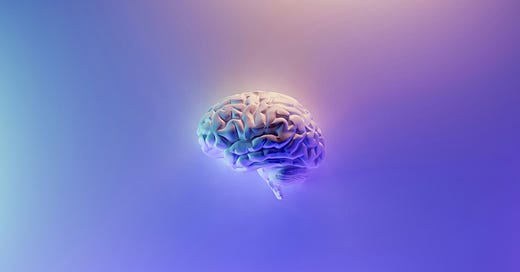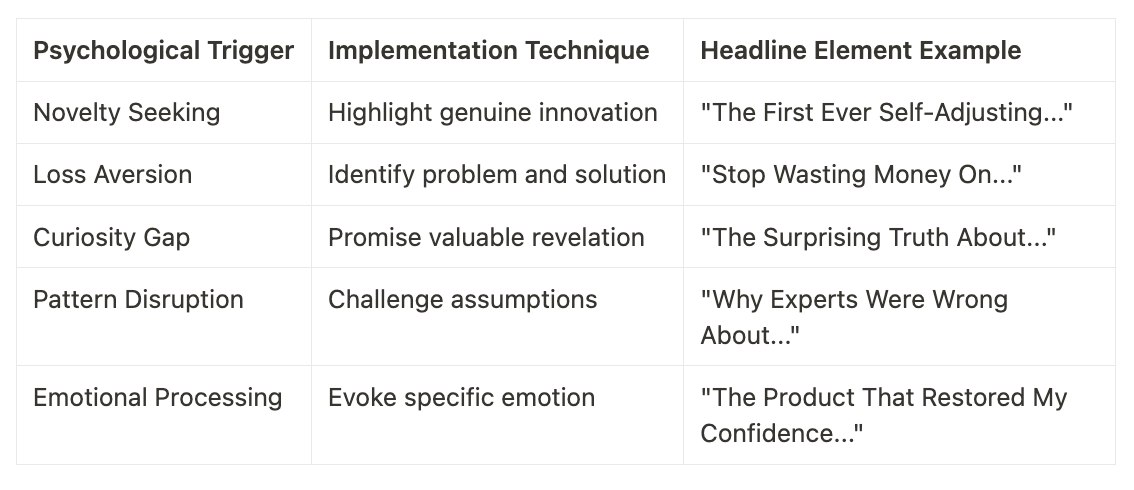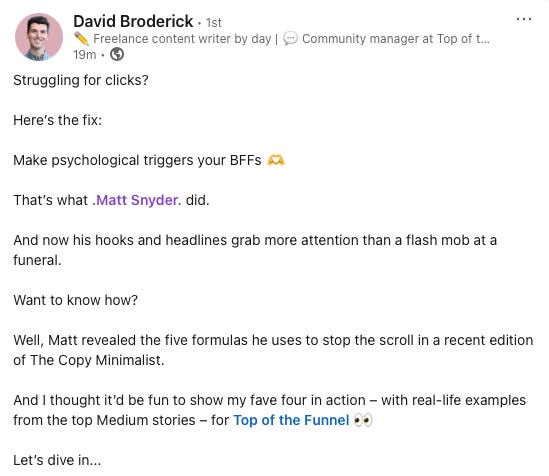The Psychology Behind Headlines That Make Customers Click: Understanding the Science of Attention
The Copywriter Column #205
In the fast-paced world of eCommerce, you have about 2 seconds to capture someone's attention before they scroll past your ad, email, or product page.
The difference between a headline that converts and one that's ignored isn't just clever wordplay—it's understanding how our brains process information and make decisions.
If you're a copywriter or marketer in the direct-to-consumer space, mastering the psychological triggers that drive customer engagement isn't a luxury—it's essential.
I've noticed that the most successful brands consistently leverage these psychological principles in their headlines, often without even realizing the science behind their success.
So today, I want to take you through the key psychological mechanisms that make certain headlines irresistible to your audience. Once you understand these principles, you'll be able to craft headlines that don't just catch the eye but drive action.
📝 Quick Note: This is a little bit of a longer read than usual (experimenting with longer form content). If you hate it, feel free to say so.The Attention Economy: Why Psychology Matters More Than Ever
You and I both live in what economists call an "attention economy"—a marketplace where human attention is the scarcest and most valuable commodity.
Think about it: the average consumer is exposed to between 4,000 and 10,000 ads daily. No wonder our brains have developed a natural filtering mechanism that screens out all the noise!
What's fascinating is that this filtering happens largely below our conscious awareness. Neuroscience research shows that our brains make initial engagement decisions within 50 milliseconds—far faster than conscious thought.
This means your headlines need to speak directly to your customers' automatic filtering system before their rational mind even gets involved.
In other words, if you don’t understand what drives people, chances of your headline sticking are small.
5 Core Psychological Triggers That Drive Headline Engagement
Let me walk you through the five psychological triggers I've found most effective for eCommerce headlines.
1. Novelty Seeking: The Brain's Reward System
The Science Behind It: Your brain actually releases dopamine when you encounter something new or unexpected. This biological response evolved to help our ancestors discover new resources and advantages.
I find it fascinating that this ancient survival mechanism now influences whether someone clicks on your product headline.
How You Can Apply It: When you signal something new or different in your headline, you trigger this novelty response. That's why phrases like "Introducing," "New Discovery," or "Revolutionary Approach" can be effective.
Look for what's truly unique about your product. Don't manufacture false novelty (your customers will see through that)—instead, highlight genuinely new aspects or innovative approaches that differentiate your offering.
2. Loss Aversion: Why Negative Headlines Often Outperform Positive Ones
The Science Behind It: We humans feel the pain of loss approximately 2x as strongly as we feel the pleasure of equivalent gains. This cognitive bias means you're more motivated to avoid losing $20 than you are excited about finding $20.
How You Can Apply It: Your headlines can identify problems, highlight mistakes, or warn about missed opportunities to tap into this powerful psychological trigger.
I'm not suggesting you create unnecessary fear—rather, acknowledge real concerns and position your product as the solution. Identify the risks or problems your product helps customers avoid.
When you frame headlines around these pain points before transitioning to your solution, you're speaking directly to one of our strongest motivational drivers.
3. Curiosity Gaps: The Power of Information Asymmetry
The Science Behind It: I love this one: when you perceive a gap between what you know and what you want to know, you experience a form of cognitive discomfort that motivates you to seek resolution.
It's like an itch in your brain that needs scratching. Research shows this state of curiosity activates the brain's reward circuits similar to hunger or thirst.
How You Can Apply It: Your headlines can hint at valuable information without revealing everything. I've found the key is signaling that the missing information is both accessible and worthwhile.
Think about what information your audience values but doesn't possess. Create headlines that acknowledge this gap and promise resolution, but please avoid pure clickbait tactics that ultimately disappoint.
I've seen those backfire spectacularly.
4. Pattern Recognition and Disruption: The Cognitive Processing Advantage
The Science Behind It: You and I both have brains that constantly seek to categorize and organize information.
When we encounter something that partially matches a familiar pattern but contains an unexpected element, it creates what psychologists call a "pattern interrupt" that demands our attention.
How You Can Apply It: I've found that headlines that rework familiar sayings, challenge conventional wisdom, or present unexpected contrasts leverage this psychological principle beautifully.
Look for common assumptions or conventions in your industry. Then create headlines that acknowledge these patterns but introduce an unexpected element that challenges the status quo.
In my experience, this technique works especially well when you're trying to differentiate from competitors (usually the middle of the funnel).
5. The Emotional Brain: Beyond Rational Benefits
The Science Behind It: Here's something that changed how I approach copywriting: neuroscience research has confirmed that emotional responses precede and influence logical reasoning.
Your headlines that trigger emotional responses create stronger memory encoding and influence purchase decisions more powerfully than purely rational appeals.
How You Can Apply It: When your headlines evoke specific emotions—whether desire, fear, curiosity, amusement, or surprise—they activate deeper brain structures than those limited to rational benefits.
Think beyond your product's features to identify the emotional outcomes it delivers. Then craft headlines that connect with these deeper emotional states.
I've found this approach particularly effective for products that might otherwise seem commoditized.
Headline Psychology in Practice: A Framework
Understanding these psychological principles is only valuable when you apply them systematically.
Here's a practical framework you can use for incorporating psychological triggers into eComm headlines:
1. Customer Mindstate Analysis
Before writing any headline, analyze the customer's current psychological state:
Awareness level: Are they actively seeking solutions or unaware of problems?
Emotional context: What emotions surround their interaction with this product category?
Information asymmetry: What valuable information do I possess that they lack?
2. Psychological Trigger Selection
Based on your analysis, select the most relevant psychological triggers:
Early awareness stages → Novelty and curiosity gaps
Problem-aware stages → Loss aversion and emotional triggers
Solution-aware stages → Pattern disruption and specificity
3. Trigger Implementation Matrix
Create headlines that incorporate selected triggers while maintaining authenticity. You might find this matrix helpful:
4. Test It!
You should always test what does and doesn’t work. Here’s what your tests should accomplish:
Tests one psychological trigger against another
Measures both click-through and conversion rates
Builds a knowledge base of which triggers work best for your specific products and audience
I can't emphasize this enough: what works for one audience might not work for another! Testing is how you'll discover your unique psychological trigger sweet spots.
Obviously, Be Ethical About It.
Let me be clear: understanding the psychology of attention comes with responsibility. In my opinion, ethical headline writing means:
Creating curiosity gaps that are satisfied, not exploited
Using loss aversion to highlight genuine risks, not manipulate through fear
Promising novelty that your product truly delivers
I firmly believe the most effective headlines can leverage psychology while maintaining trust—the foundation of long-term customer relationships.
The Bottom Line
I want to leave you with this thought: instead of asking "What should my headline say?" start by asking "What psychological need should my headline address?"
This fundamentally different approach has transformed my headline writing from guesswork into strategic communication.
As you develop your headlines, remember that these psychological principles aren't manipulation tactics—they're communication tools that help you connect customers with products that genuinely meet their needs.
Want more posts like this in your inbox?
Want some more examples?
Check out this post from David Broderick. He uses the above article to find examples of these psychological triggers at work in the wild!
🛒 Further Reading for the Book Nerds
Interested in learning more about the intersection of marketing and behavioral psychology? You might like these books:*
Buy•ology: Truth and Lies About Why We Buy by Martin Lindstrom
Choice Hacking: How to Use Psychology and Behavioral Science to Create an Experience that Sings by Jennifer Clinehens
Marketing to Mindstates: The Practical Guide to Applying Behavior Design to Research and Marketing by Will Leach
Methods of Persuasion by Nick Kolenda
Persuasive Copywriting: Cut Through the Noise and Communicate With Impact by Andy Maslen
Using Behavioral Science in Marketing: Drive Customer Action and Loyalty by Prompting Instinctive Responses by Nancy Harhut
*Contains affiliate links
The Copywriter Column is a weekly glimpse into the mind of an agency copywriter. Thinking about subscribing? Here’s what else you can expect.






